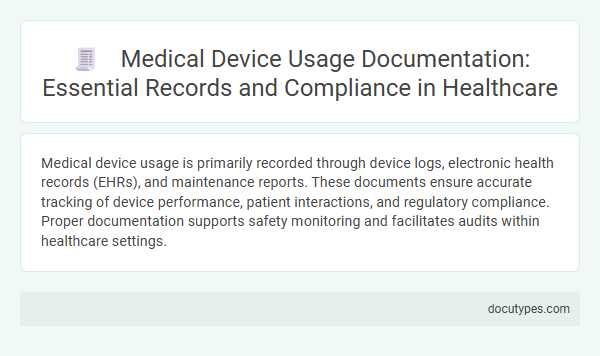Medical device usage is primarily recorded through device logs, electronic health records (EHRs), and maintenance reports. These documents ensure accurate tracking of device performance, patient interactions, and regulatory compliance. Proper documentation supports safety monitoring and facilitates audits within healthcare settings.
Introduction to Medical Device Usage Documentation
Medical device usage documentation is essential for ensuring patient safety and regulatory compliance. Common documents include device usage logs, maintenance records, and incident reports. You should maintain accurate records to track the performance and history of medical devices effectively.
Importance of Accurate Record-Keeping
Accurate record-keeping is essential for tracking the usage of medical devices to ensure patient safety and regulatory compliance. Detailed documentation supports device maintenance, usage patterns, and incident reporting.
- Device Usage Logs - These logs capture the date, time, and user information for every instance a medical device is operated, providing a clear history of use.
- Maintenance and Calibration Records - Records document regular inspections and calibrations, ensuring devices function correctly and meet safety standards.
- Incident and Adverse Event Reports - These reports document any malfunctions or adverse events related to device use, crucial for risk management and improving device safety.
Regulatory Requirements for Device Documentation
What documents are used for recording medical device usage in regulatory contexts? Medical device usage must be meticulously documented to ensure compliance with regulatory standards such as FDA 21 CFR Part 820 and ISO 13485. These records include Device History Records (DHR), Device Master Records (DMR), and logbooks that track device operation, maintenance, and user training.
Key Elements of Medical Device Records
Medical device usage is commonly documented through Device History Records (DHR), Medical Device Reports (MDR), and Maintenance Logs. Key elements of these records include device identification, usage dates, operator details, and any observed malfunctions or adverse events. Accurate documentation ensures regulatory compliance, traceability, and patient safety throughout the device lifecycle.
Best Practices for Documenting Device Usage
| Document Type | Description | Best Practices for Documenting Device Usage |
|---|---|---|
| Device Usage Logs | Records detailing each instance of medical device operation, including time, date, and user. | Ensure logs are updated in real-time; include device serial numbers and maintenance status to track performance and minimize downtime. |
| Maintenance and Calibration Records | Documentation of routine maintenance, calibration activities, and repairs performed on medical devices. | Maintain detailed schedules; document technician credentials and calibration results to guarantee device accuracy and compliance with regulatory standards. |
| Patient Care Records | Clinical records that integrate device usage as part of patient treatment documentation. | Link device usage directly to patient IDs and procedures; include device settings and operational parameters for traceability. |
| Inventory Management Systems | Digital platforms tracking device allocation, usage frequency, and availability. | Employ barcode or RFID tagging; record user activities and update inventory status promptly to optimize device allocation. |
| Incident and Adverse Event Reports | Reports documenting device malfunctions or adverse events related to device use. | Record detailed descriptions, timestamps, and corrective actions; use standardized forms to facilitate regulatory reporting and risk mitigation. |
Compliance with Healthcare Standards and Laws
Medical device usage must be documented using specific records such as Device Usage Logs, Maintenance Records, and Incident Reports to ensure compliance with healthcare standards. These documents provide detailed information about device operation, patient interactions, and any malfunctions or adverse events.
Regulatory frameworks like FDA, ISO 13485, and HIPAA require precise record-keeping to maintain transparency and accountability. Your adherence to these documentation standards helps safeguard patient safety and supports legal compliance in clinical settings.
Electronic vs. Paper-Based Documentation Systems
Medical device usage is documented through both electronic and paper-based systems, each having distinct advantages and challenges. The choice between these methods impacts accuracy, accessibility, and regulatory compliance in healthcare settings.
- Electronic Documentation Systems - Utilize digital platforms to record device usage, enabling real-time data entry and easier data management.
- Paper-Based Documentation Systems - Rely on physical forms and logs that provide a tangible record but are prone to loss or damage.
- Regulatory Compliance - Both systems must adhere to strict healthcare regulations such as FDA guidelines and ISO standards to ensure accurate and reliable medical device tracking.
Common Documentation Challenges and Solutions
Medical device usage is primarily recorded through patient charts, electronic health records (EHRs), device logs, and maintenance records. Accurate documentation ensures patient safety, regulatory compliance, and effective device management.
Common challenges include inconsistent data entry, missing information, and integration issues between multiple record systems. Solutions involve standardized documentation protocols, staff training, and the implementation of interoperable EHR systems to streamline data capture and retrieval.
Role of Documentation in Patient Safety
Medical device usage is recorded through various documents such as device logs, patient records, and maintenance reports. These documents ensure accurate tracking of device performance and patient interactions.
Documentation plays a crucial role in patient safety by providing a clear history of device application and any associated risks. Proper records allow healthcare professionals to identify potential issues early and maintain compliance with safety standards. You can contribute to safer care by ensuring all medical device usage is thoroughly documented and reviewed.
Which Documents Are Used for Recording Medical Device Usage? Infographic

